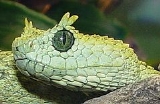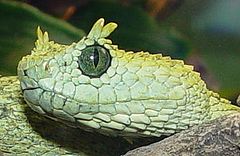
Ocular scales
Encyclopedia

Squamata
Squamata, or the scaled reptiles, is the largest recent order of reptiles, including lizards and snakes. Members of the order are distinguished by their skins, which bear horny scales or shields. They also possess movable quadrate bones, making it possible to move the upper jaw relative to the...
, the ocular scales are those forming the margin of the eye. The name originates from the term oculus
Oculus
An Oculus, circular window, or rain-hole is a feature of Classical architecture since the 16th century. They are often denoted by their French name, oeil de boeuf, or "bull's-eye". Such circular or oval windows express the presence of a mezzanine on a building's façade without competing for...
which is Latin
Latin
Latin is an Italic language originally spoken in Latium and Ancient Rome. It, along with most European languages, is a descendant of the ancient Proto-Indo-European language. Although it is considered a dead language, a number of scholars and members of the Christian clergy speak it fluently, and...
for "eye" and, in the broadest sense, refers to a scale associated with the eye
Eye
Eyes are organs that detect light and convert it into electro-chemical impulses in neurons. The simplest photoreceptors in conscious vision connect light to movement...
. The numbers of these scales present, and sometimes the shapes and sizes, are some of many characteristics used to differentiate species from one another.
Prefixes are usually included to indicate the positions or locations of the individual scales:
- Preocular scales, or preoculars, are those lying directly in front of and in contact with the eye.
- Postocular scales, or postoculars, are those lying directly behind and in contact with the eye.
- Supraocular scalesSupraocular scalesIn scaled reptiles, supraocular scales are scales on the crown immediately above the eye. The size and shape of these scales are among the many characteristics used to differentiate species from each another....
, or supraoculars, are enlarged scales on the crown immediately above the eye. - Subocular scales, or suboculars, are those lying directly below and in contact with the eye.
Collectively these scales are referred to as circumorbital scales, circumorbitals, or a circumorbital ring.
Occasionally, the term ocular scale is used without a prefix, in which case it specifically refers to the brille
Brille
The brille is the layer of transparent, immovable disc-shaped skin or scale covering the eyes of some animals for protection, especially in animals without eyelids. The brille has evolved from a fusion of the upper and lower eyelids...
, also known as the spectacle or eyecap. This is a transparent scale that covers and protects the eye. It is formed in embryonic snakes when the transparent upper and lower eyelids fuse together. Once hatched, a snake does not possess eyelids and the brille carries out some of these functions.
See also
- BrilleBrilleThe brille is the layer of transparent, immovable disc-shaped skin or scale covering the eyes of some animals for protection, especially in animals without eyelids. The brille has evolved from a fusion of the upper and lower eyelids...
- Ocular (disambiguation)OcularOcular may refer to:* Eye, an organ of vision that detects light* Eyepiece, the optical element closest to the eye in a telescope or microscope* Ocular scale, a type of scales in reptilesRomania:...
- Snake scalesSnake scalesSnakes, like other reptiles, have a skin covered in scales. Snakes are entirely covered with scales or scutes of various shapes and sizes. Scales protect the body of the snake, aid it in locomotion, allow moisture to be retained within, alter the surface characteristics such as roughness to aid in...
- Anatomical terms of locationAnatomical terms of locationStandard anatomical terms of location are designations employed in science that deal with the anatomy of animals to avoid ambiguities that might otherwise arise. They are not language-specific, and thus require no translation...

